So, you have a keyfob that is damaged, scratched, haggered rubber buttons, or generally looks crap. You don't fancy forking out £165+ for a new one. Well, this should help you.
Providing you already have a remote keyfob, and the electronics and key work, then this guide is for you.
There are numerous versions of replacement casings, some can use your existing key blade, and others you will have to get the supplied blade cut.
IF YOU ARE UNSURE WHICH CASING TO BUY, USE THE DISASSEMBLY GUIDE TO DETERMINE WHICH CASE YOU NEED, PAYING ATTENTION TO THE KEY PIVOT LOCKING FIXTURE. BUY ONE THAT MATCHES YOUR EXISTING KEY (like shown in step 6)
DISCLAIMER: NOR MYSELF OR THIS FORUM WILL BE HELD RESPONSIBLE IF YOU DAMAGE YOUR KEYFOB. THIS IS A GUIDE AND SHOULD NOT BE ATTEMPTED BY ANYONE THAT IS NOT COMFORTABLE TAKING THINGS APART
What you will need:
Posi-drive hobby screwdriver
Thin flat-head hobby screwdriver
Craft blade or Stanley knife
Grease (although not essential)
A fresh brew
Step 1
To start, first remove the battery from the keyfob. This has a screw lock that will release the slide-out battery tray.

Step 2
Use the thin flathead screwdriver or fine edge of your blade to slip in between the badge and the casing. Lever the badge out of the recess (it is stuck down with an adhesive pad).
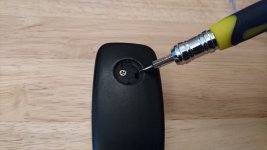
Step 3
Remove the screw that has been revealed.
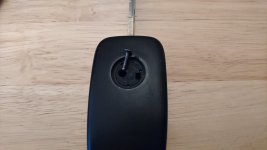
Step 4
With the key in it's outward position, use both thumbs to pry the casing apart at the bottom of the key. Once this has parted, hold onto the key blade and gently pry the top apart.

Step 5
Gently lift out the circuit board from the casing.
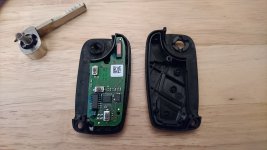
Step 6
Gently remove your transponder chip (circled red) if there is one present, using a thin flathead screwdriver (Some keys have one fitted, some are located on the circuit board, model dependant). It is at this point you will need to reference which replacement casing you need to buy. Pay particular attention to the key's locking lugs circled in green, buy the casing that matches yours if you want one that can swap the key blade over.

Now you have the key disassembled, you are ready to swap the contents into the new casing.
Providing you already have a remote keyfob, and the electronics and key work, then this guide is for you.
There are numerous versions of replacement casings, some can use your existing key blade, and others you will have to get the supplied blade cut.
IF YOU ARE UNSURE WHICH CASING TO BUY, USE THE DISASSEMBLY GUIDE TO DETERMINE WHICH CASE YOU NEED, PAYING ATTENTION TO THE KEY PIVOT LOCKING FIXTURE. BUY ONE THAT MATCHES YOUR EXISTING KEY (like shown in step 6)
DISCLAIMER: NOR MYSELF OR THIS FORUM WILL BE HELD RESPONSIBLE IF YOU DAMAGE YOUR KEYFOB. THIS IS A GUIDE AND SHOULD NOT BE ATTEMPTED BY ANYONE THAT IS NOT COMFORTABLE TAKING THINGS APART
What you will need:
Posi-drive hobby screwdriver
Thin flat-head hobby screwdriver
Craft blade or Stanley knife
Grease (although not essential)
A fresh brew
Step 1
To start, first remove the battery from the keyfob. This has a screw lock that will release the slide-out battery tray.

Step 2
Use the thin flathead screwdriver or fine edge of your blade to slip in between the badge and the casing. Lever the badge out of the recess (it is stuck down with an adhesive pad).

Step 3
Remove the screw that has been revealed.

Step 4
With the key in it's outward position, use both thumbs to pry the casing apart at the bottom of the key. Once this has parted, hold onto the key blade and gently pry the top apart.

Step 5
Gently lift out the circuit board from the casing.

Step 6
Gently remove your transponder chip (circled red) if there is one present, using a thin flathead screwdriver (Some keys have one fitted, some are located on the circuit board, model dependant). It is at this point you will need to reference which replacement casing you need to buy. Pay particular attention to the key's locking lugs circled in green, buy the casing that matches yours if you want one that can swap the key blade over.

Now you have the key disassembled, you are ready to swap the contents into the new casing.
Re-assembly
Now you have your replacement housing, you may have to make some modifications to fit your existing parts. This will be explained in each step. Please take note: Use the existing release button and spring in your new housing. The new spring and button will cause issues unless used with the new blade (which will require cutting at a locksmiths)
Step 1
Ensure the battery terminals are seated correctly and securely in the new housing.
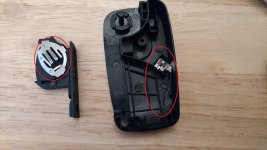
Step 2
Insert your transponder chip into the area circled. Test fit your circuit board into the housing, ensuring it sits flush.

If it does not sit flush (like mine did due to transponder on board), then you will need to take your blade and cut away the little plastic support tab circled
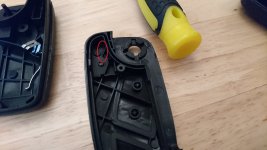
Step 3
Test fit your key blade and ensure it pivots the entire 180 degrees from closed to open. Mine stopped 1 degree short of full open (where the button latches in the locked position). Take your craft/stanley blade and shave the tinyest bit of plastic off the tall stub. Retest the key and repeat until you have the full 180 degree movement.
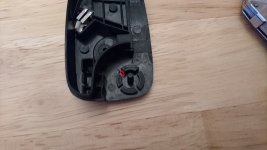
Step 4
Insert the release button and spring onto the key hinge, placing the bottom leg of the spring in the slot circled. Then place the key onto the release button, ensuring it goes right through the centre of the hole. Then, while pushing down against the spring tension, rotate the key anti-clockwise TWICE and push it flat against the housing. Then take the top part of the housing (witht he circuit board inserted) and place on top of the bottom part of the housing while holding the key in place.
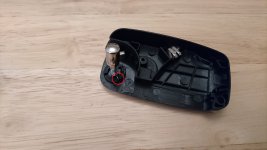
Step 5
While holding the 2 housing parts together, take the new screw and place it through the hole on the bottom casing and screw it in firmly. Take care not to overtighten.
Step 6
Test the key flip mechanism. If it feels graunchy or scratchy, take it apart again, and place very small dabs of grease on the tops of the plastic pivot surfaces. If you are happy with the tension and locking, then take the new logo and place it over the screw recess on the back of the casing.
Step 7
Insert the battery into the holder, then place into the key and secure the locking screw.
Step 8
Test key in lock, and test remote.
Step 9
Finish your cuppa and congratulate yourself on a job well done!


